
Researchers at Northwestern University have discovered that the structural features of the brain are near a critical point similar to a phase transition, observed in various species such as humans, mice, and fruit flies. This finding suggests a universal principle may govern brain structure, which could inspire new computational models to emulate brain complexity.
The brain exhibits structural criticality near phase transitions, consistent across species, potentially guiding the development of new brain models.
When a magnet is heated, it reaches a critical point where it loses magnetization, known as “criticality.” This point of high complexity is reached when a physical object is undergoing a phase transition.
Recently, researchers from Northwestern University have discovered that the brain’s structural features reside near a similar critical point — either at or close to a structural phase transition. These results are consistent across brains from humans, mice, and fruit flies, which suggests the finding might be universal. While it remains unclear which phases the brain’s structure is transitioning between, these findings could enable new designs for computational models of the brain’s complexity.
Their research was published in Communications Physics.
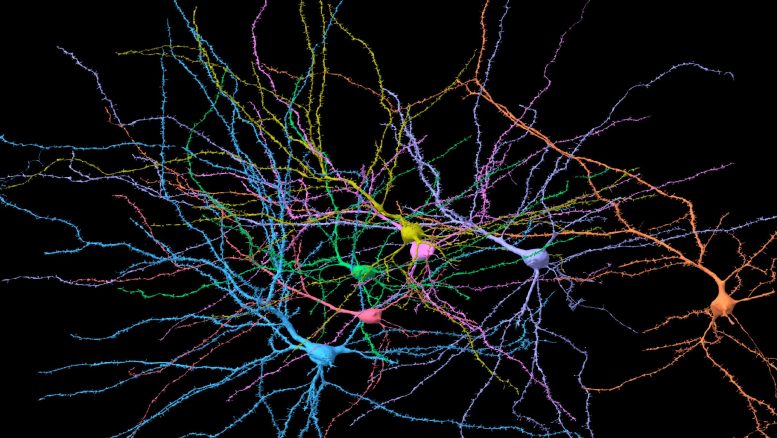
3D reconstruction of select neurons in a small region of the human cortex dataset. Credit: Harvard University/Google
Brain Structure and Computational Models
“The human brain is one of the most complex systems known, and many properties of the details governing its structure are not yet understood,” said senior author István Kovács, an assistant professor of physics and astronomy at Northwestern.
“Several other researchers have studied brain criticality in terms of neuron dynamics. But we are looking at criticality at the structural level in order to ultimately understand how this underpins the complexity of brain dynamics. That has been a missing piece for how we think about the brain’s complexity. Unlike in a computer where any software can run on the same hardware, in the brain the dynamics and the hardware are strongly related.”
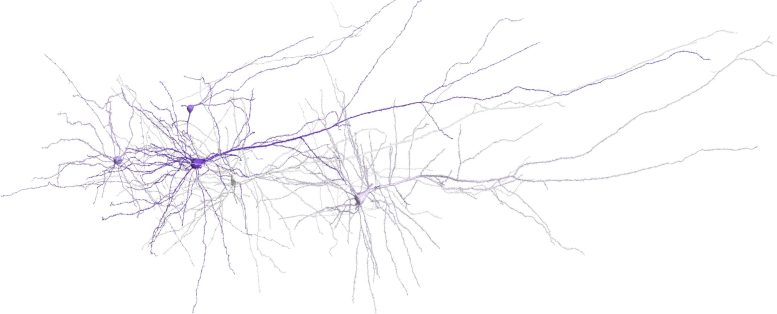
3D reconstruction of select neurons in a small region of the human cortex dataset. Credit: Harvard University/Google
“The structure of the brain at the cellular level appears to be near a phase transition,” said first author Helen Ansell, a Tarbutton Fellow at Emory University who was a postdoctoral researcher in Kovács’s lab during the study. “An everyday example of this is when ice melts into water. It’s still water molecules, but they are undergoing a transition from solid to liquid. We certainly are not saying that the brain is near melting. In fact, we don’t have a way of knowing what two phases the brain could be transitioning between. Because if it were on either side of the critical point, it wouldn’t be a brain.”
Applying Statistical Physics to Neuroscience
Although researchers have long studied brain dynamics using functional magnetic resonance imaging (fMRI) and electroencephalograms (EEG), advances in neuroscience have only recently provided massive datasets for the brain’s cellular structure. These data opened possibilities for Kovács and his team to apply statistical physics techniques to measure the physical structure of neurons.
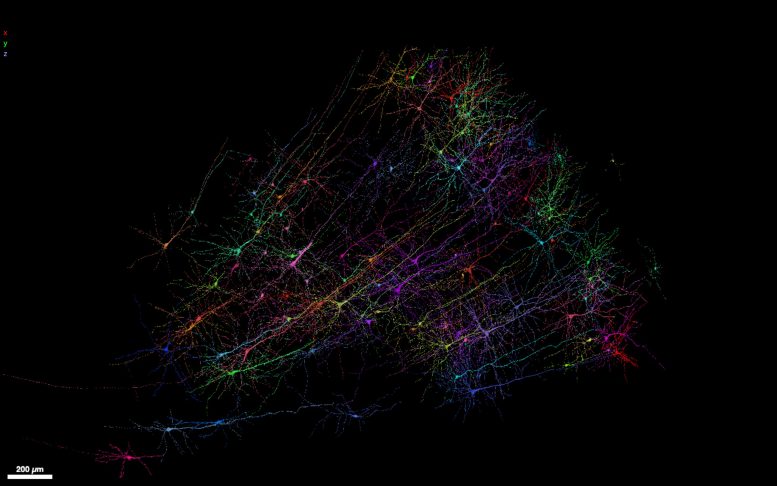
Snapshot of select neurons from the human cortex dataset, viewed using the online neuroglancer platform. Credit: Harvard University/Google
Identifying Critical Exponents in Brain Structure
Kovács and Ansell analyzed publicly available data from 3D brain reconstructions from humans, fruit flies, and mice. By examining the brain at nanoscale resolution, the researchers found the samples showcased hallmarks of physical properties associated with criticality.
One such property is the well-known, fractal-like structure of neurons. This nontrivial fractal-dimension is an example of a set of observables, called “critical exponents,” that emerge when a system is close to a phase transition.
Brain cells are arranged in a fractal-like statistical pattern at different scales. When zoomed in, the fractal shapes are “self-similar,” meaning that smaller parts of the sample resemble the whole sample. The sizes of various neuron segments observed also are diverse, which provides another clue. According to Kovács, self-similarity, long-range correlations and broad size distributions are all signatures of a critical state, where features are neither too organized nor too random. These observations lead to a set of critical exponents that characterize these structural features.
“These are things we see in all critical systems in physics,” Kovács said. “It seems the brain is in a delicate balance between two phases.”
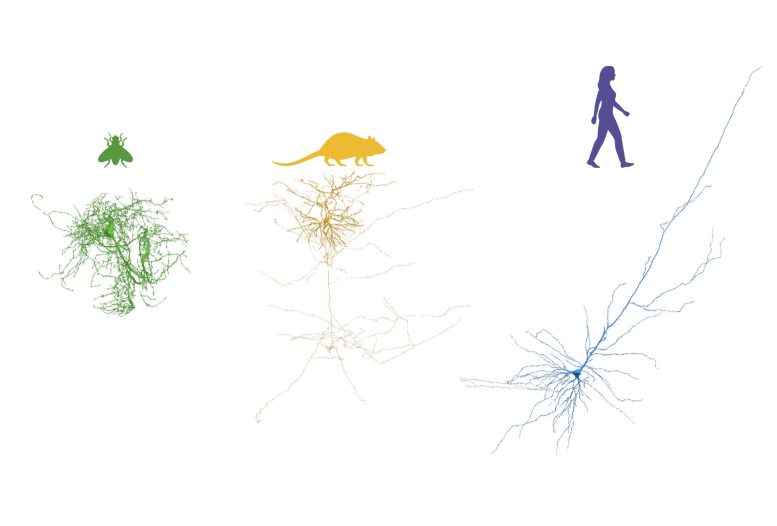
Examples of a single neuron reconstruction from each of the fruit fly, mouse and human datasets. Credit: Northwestern University
Universal Criticality Across Species
Kovács and Ansell were amazed to find that all brain samples studied — from humans, mice and fruit flies — have consistent critical exponents across organisms, meaning they share the same quantitative features of criticality. The underlying, compatible structures among organisms hint that a universal governing principle might be at play. Their new findings potentially could help explain why brains from different creatures share some of the same fundamental principles.
“Initially, these structures look quite different — a whole fly brain is roughly the size of a small human neuron,” Ansell said. “But then we found emerging properties that are surprisingly similar.”
“Among the many characteristics that are very different across organisms, we relied on the suggestions of statistical physics to check which measures are potentially universal, such as critical exponents. Indeed, those are consistent across organisms,” Kovács said. “As an even deeper sign of criticality, the obtained critical exponents are not independent — from any three, we can calculate the rest, as dictated by statistical physics. This finding opens the way to formulating simple physical models to capture statistical patterns of the brain structure. Such models are useful inputs for dynamical brain models and can be inspirational for artificial neural network architectures.”
Moving forward, the researchers plan to apply their techniques to emerging new datasets, including larger sections of the brain and more organisms. They aim to find if the universality will still apply.
Reference: “Unveiling universal aspects of the cellular anatomy of the brain” by Helen S. Ansell, and István A. Kovács, 10 June 2024, Communications Physics.
DOI: 10.1038/s42005-024-01665-y
Funding: This study was partially supported through the computational resources at the Quest high-performance computing facility at Northwestern.



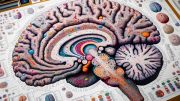




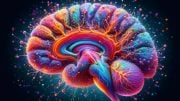
I was amused to read a recent article saying Einstein had another gravity “theory” where the author managed to avoid deciding how to handle with a loss of constancy in “c.” You could say that metastability and decision circuits don’t require a brain or even a single neuron, although generalizing that toward universality doesn’t seem to add much to the picture.
Seems a basic concept there is that a pre-decision state requires some elevated dissipation level to be maintained, and the post decision state is a relatively “relaxed” state maintained with reduced dissipation, alternatively you could view decisions as dissipative. I suppose it’s about as arbitrary as deciding what qualifies as information in information theory, but it’s naturally cast in an analog form.
Anyway, the idea of gravitational sources exhibiting gravitational decisions would require quantizing gravity.
I mean as a science “expert” it was a way to avoid deciding how to handle *anything at all* with a loss of constancy in “c.”
Speaking of critical exponentiation and quantizing gravity if using exponents to posit a “Large Number” hypothesis similar to Dirac’s LNH …. Though it’s well known (think “slide rules”) that every real number has an exponential form by which multiplication is reduced to addition, no one should be surprised that some rando can get prominently quoted cryptically saying “1×1=2” and cryptically suggesting they also have deep gravity insights about some failure of GR, just as no one should expect that leading gravity science parrots will get dragged into the mess without failing to suggest he’s just using exponential notation to form an equation in exponents that will agree with any arbitrary base, like (10)^1 x (10)^1 = 10^2.
Thing about supermassive black holes that really caught my attention is the physicist who says they generate historical evidence of pivoting their spin axis around to face different surrounding objects. Maybe it solves the question of how BHs handle all the information that falls in. Beyond appearing somewhat decision-like or metastable, the theme of counter-entropic (counter-dissipative) gravitational retro-reflection fits in there perfectly, as there’s nothing realistically less dissipative and more self-energy-conserving than energy retro-reflection. This sort of elaborate SMBH behavior with surrounding objects, supposing such objects are entangled remnants of historic major infalls, then an extended history of BH spin pivots would be a manifestation of an extreme form of gravitational entanglement.
The statistical find is nothing new. “A canonical example of a complex system is the human brain, whose large numbers of neuronal cells display nontrivial multiscale organization8,9 and complex characteristics10,11. It has also been discovered that power-law statistics, often used to describe critical phase transitions, are present in the brain.” [Janarek, J., Drogosz, Z., Grela, J. et al. Investigating structural and functional aspects of the brain’s criticality in stroke. Sci Rep 13, 12341 (2023).]
It is also very common for long range organization (which is what e.g. second order phase transitions acquire). “When similar patterns repeatedly emerge at smaller and smaller scales, we can analyze them mathematically and see if they have the same statistical characteristics as the larger structures; if they do, it’s fractal-like in nature. So, is the Universe itself a fractal? The answer appears to be almost, but not quite. … On the largest scales in the Universe, gravitation is the only force that matters. Under many circumstances, if you wait long enough, gravitational collapse will produce identical structures, just scaled up or down in size depending on the size of your system. … When you take all of this together, it helps us realize a true but perhaps counterintuitive fact about the Universe: on both the smallest and largest cosmic scales, the Universe is not fractal-like at all, and that only the intermediate scales have any chance at exhibiting fractal-like behavior.” [Ethan Siegel, STARTS WITH A BANG — DECEMBER 28, 2021, “Is the universe actually a fractal?”] But e.g. the universe is not thinking…